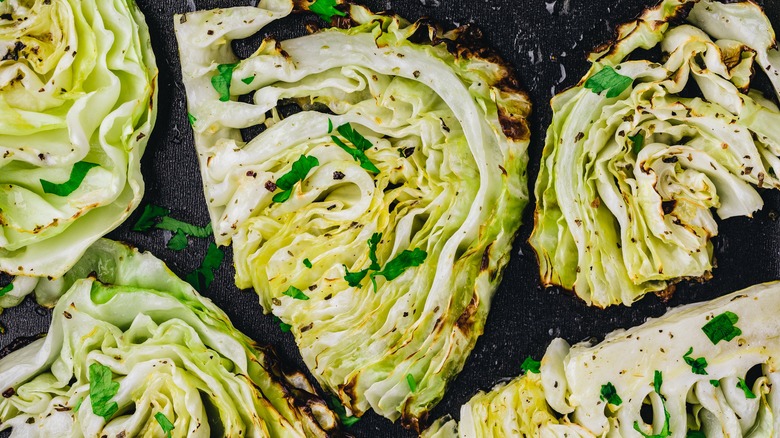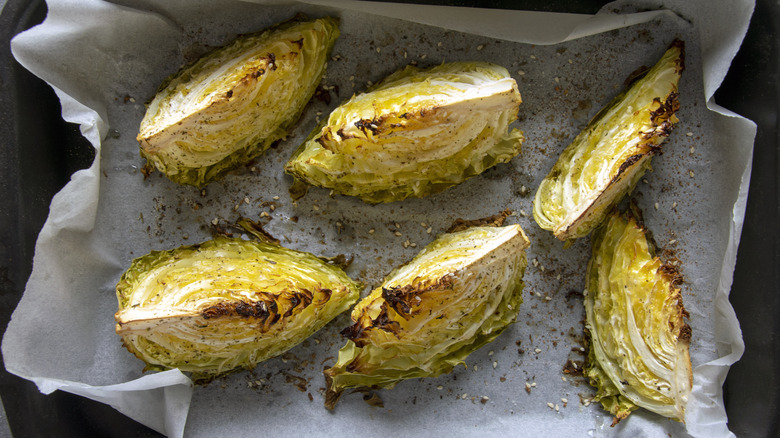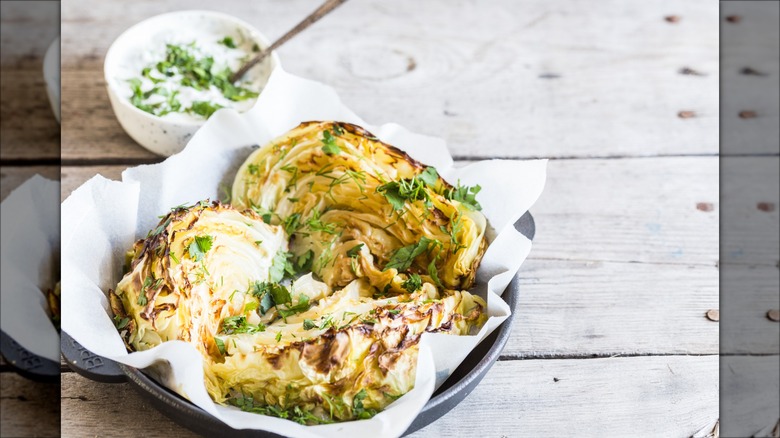Expert-Approved Tips For The Best Roasted Cabbage Ever
We may receive a commission on purchases made from links.
You might be most familiar with cabbage in its raw form; you'll frequently find it sliced or shredded in salads or coleslaw or drenched in dressing. Cabbage is a little spicy when it's raw, with a touch of pepperiness and tang. But that sharpness evens out when the leafy vegetable is cooked, becoming more sweet and less pungent. So you can't miss out on roasted cabbage.
There are a lot of mistakes you might be guilty of making when cooking cabbage, though. Because when you get heat involved, things can become tricky. If you aren't careful, the cabbage can become soggy, tough, or bland. So vegan recipe developer Remy Park came to the roasted cabbage rescue. The wellness content creator and author of the "Sesame, Soy, Spice" cookbook has a few tips for perfectly roasting cabbage every time.
It starts with the cut. "I recommend slicing cabbage into wedges to make it easier and quicker to roast!" Park told Daily Meal. She also says that slicing cabbage into steaks works too. In addition to cutting down on the cooking time of a whole head of cabbage, wedges or steaks allow you to increase the surface area that gets deliciously crispy while they roast. Steaks will have lots of caramelized, browned edges, while wedges will have crispy edges and a softer center. Either way, that crispiness is a big part of roasted cabbage's appeal, so Park has tips for achieving that char.
How to perfectly char cabbage
Once you've decided on a cut, it's time to get cooking. But even though "roasting" signals the use of the oven, that isn't where Remy Park suggests you start cooking your cabbage. Instead, begin on the stovetop with a pan. "Use a heavy-bottomed pan or one that can handle heat," she says, "so you can get a nice char going on the cabbage before throwing it in the oven to roast."
Give the pan a liberal dose of neutral oil, then let the cabbage wedges or steaks sit in the pan for a bit to start getting some color. Then flip and repeat on the other side. Before the cabbage even reaches the oven, those brown, crispy edges will begin to develop. Park offers a couple of options as a next step: Add some herbs and spices for flavor and let the cabbage stay in the pan while you baste with any oil you like (or butter, if you prefer), then move it to the oven. Or, if you want a more hands-off version of the method, she says you can char both sides, skip the basting, and stick it straight in the oven on a lined baking sheet to finish its roasting.
Seasoning cabbage for roasting
Remy Park's perfect stovetop cabbage char begins with a neutral oil, but she suggests choosing one that can withstand high heat. You're not cooking the cabbage low and slow here; you want it to get crispy and brown on the outside before the oven cooks it through, and that will take a real sizzle. Canola oil, grapeseed oil, and vegetable oil are all neutral oils that have a higher smoke point, which means that you can cook with them at a higher temperature, and they won't burn or give food that sharp, bitter taste.
If you want the cabbage to have a little more time in the pan once both sides are charred, Park suggests adding some aromatics while you baste. There are a lot of directions you can go to take the cabbage's flavor to the next level. It doesn't have to be complicated, though; any aromatics — from garlic and lemon to cumin and coriander – will be an easy addition to at-home roasted cabbage. When it's cooked, serve your cabbage wedges with a spicy lime dressing for a fresh and creamy taste, or add a nice kick to bland cabbage with horseradish.


